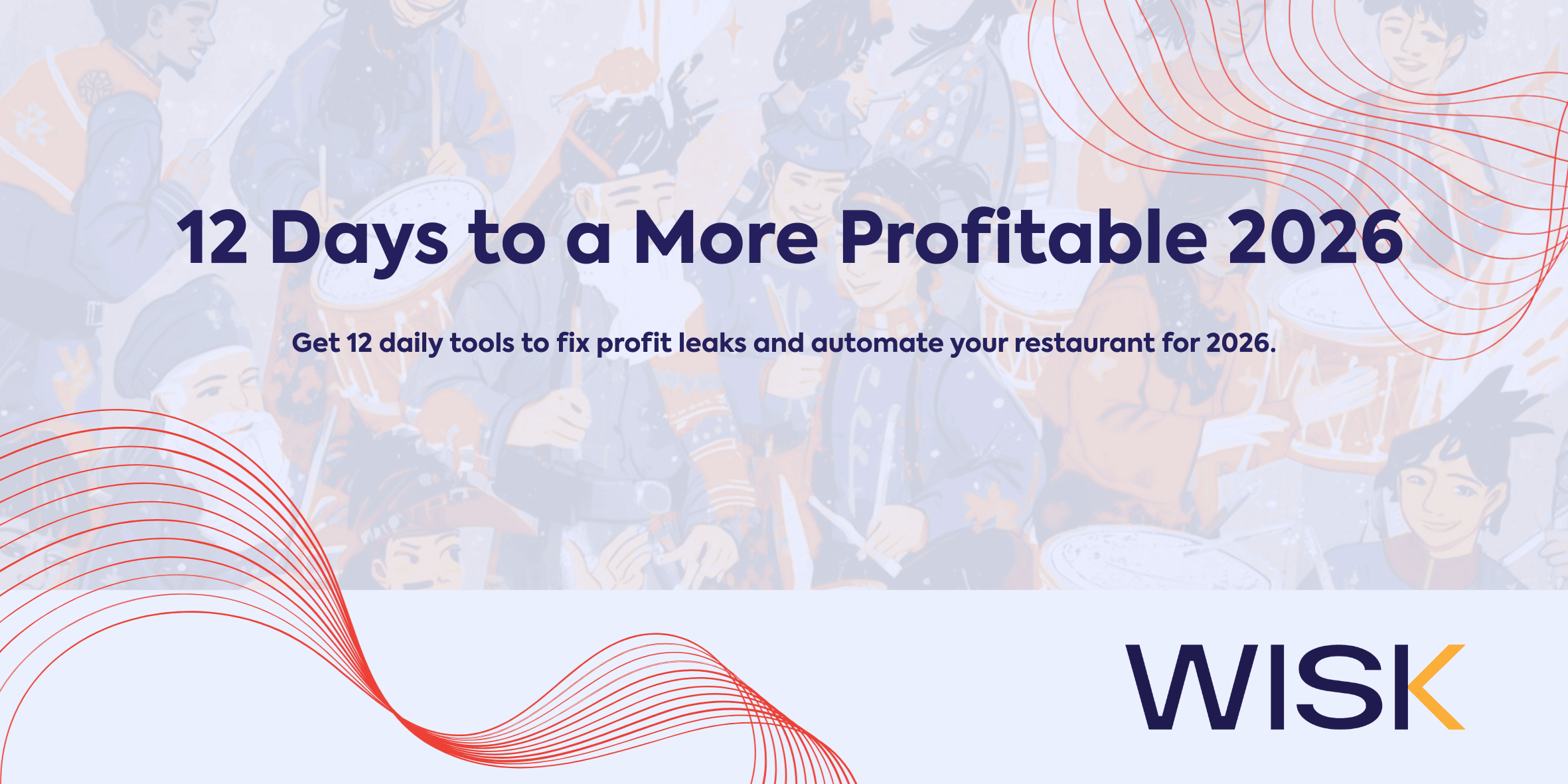Fast-casual used to be the darling of the restaurant business: fresher food than fast food, lower friction than full service, and margins that looked promising when diners were spending.
Lately, that glow is dimming. Same-store sales are softer, traffic is patchy, and operators are asking a practical question: what changed, and what should we do during the restaurant's slow season and slow months ahead?
Below is a frank look at why restaurants slow down, what’s driving consumer behavior, and real tactics restaurant owners and managers can use to increase restaurant sales and maintain strong restaurant performance, even in a slow period. I’ll finish with a short note on how WISK can help that effort.
Snapshot: the numbers and the mood
Over the last year the industry has seen growth shrink compared to earlier post-pandemic rebounds. Large data sets and industry reports show restaurant sales climbing, but at a much more modest pace than 2021–2022 boom years.
Some fast-casual chains that posted robust growth are now reporting flat or negative comp sales, and analysts point to weaker traffic and consumers rethinking where and how they spend on meals.
According to Nation's Restaurant News, Technomic’s Top 500 also flagged slower sales across chain restaurants, growth is still positive in many segments, but the rate has cooled and that matters when costs stay elevated. The industry’s seasonal swings, holiday season spikes, summer months softness or winter weather hits, are back in focus as operators look for ways to smooth revenue through the year.
The short list of why fast-casual sales are slowing
There’s no single villain. Here are the realities most restaurants are feeling:
- Price increases and value fatigue. After two years of steady menu price growth, many consumers are tightening what they spend on out-of-home meals. When a typical meal starts to feel expensive, fewer impulse visits happen. This is why promotions and loyalty programs are suddenly front-page strategy.
- Traffic shifts, not just pricing. Some groups, especially cost-squeezed younger consumers, are simply eating out less or trading down to cheaper options. This changes how many guests come through the door and the average check.
- Menu fatigue and lack of differentiation. If your menu looks like six other fast-casual brands down the street, diners have less reason to choose you. New dishes, curated specials, and seasonal tweaks can keep eyes and wallets on your brand.
- Delivery and digital complexity. Delivery lifted revenue for many operators, but it also introduced fees, margin pressure, and operational headaches. Poorly integrated delivery can actually harm service and reduce repeat business.
- Weather and seasons. Harsh winter weather, summer months with fewer tourists in some markets, and the traditional slow period after holidays all bite into foot traffic.
Short history: how we got here (in plain terms)
Fast-casual’s rise was driven by convenience, perception of value, and a taste for fresher or “better” food at scale. Operators invested in tech, loyalty, and off-premise channels to capture demand.
When the economy loosened after the pandemic, consumers rewarded those investments.
Then inflation and wage pressure arrived; margins tightened; consumers grew choosier. That combination turned a high-growth lane into a competitive field where only the most adaptable restaurants keep pace.

Seasonal patterns: when slow matters most
Every restaurant knows the calendar matters. There’s the holiday season bump, big spend, big parties. There’s the new year reset where consumers cut back.
Summer months can be golden for some concepts and doldrums for others. And harsh winter weather can wipe out a week of dinner covers in a single storm.
Actions that work during a slow season:
- Plan promotions for the immediate post-holiday slow period. Offer bundled family deals to attract customers coming in for a quick, affordable dinner.
- In summer months, test lighter menu items and daytime offers, lunch traffic can recover faster than dinner.
- For winter, lean on delivery, warming dishes, and comfort food promotions that put diners in the door despite weather.
Tactical playbook: concrete moves to increase restaurant sales now
Here are practical strategies that work during a slow period, organized into marketing, menu, and operations.
Marketing & loyalty: turn guests into repeat guests
- Loyalty programs matter. Reward your most loyal customers with early access deals or exclusive discounts so they feel prioritized. Small perks (a free side after X visits) often cost less than new customer acquisition and bring bigger lifetime value.
- VIP windows for most loyal customers. Offer limited-time discounts to this group during slow months, people respond to scarcity and personalization.
- Local partnerships. Team up with offices, gyms, or schools for weekday lunch deals that drive steady traffic.
- Use targeted promos to attract customers during specific slow days, for example “Two for Tuesday” or “family bundle” for weekday dinners.
Menu & pricing: make every dish pull weight
- Curate, don’t clutter. Remove low-selling dishes and spotlight high-margin winners. Fewer quality options reduce waste and boost ticket value.
- Seasonal dishes create reasons for guests to return. Rotate a winter comfort special, a spring lighter plate, or a summer salad that updates often.
- Smart price increases. When costs force price hikes, protect perceived value by slightly increasing portion size or adding a visual upgrade so guests feel they’re still getting a good meal.
Off-premise & delivery: make it profitable
- Negotiate delivery fees or use blended pricing to protect margins. If delivery is uncontrolled, it can erode the gains during slow weeks.
- Offer pickup incentives. Small discounts for pickup orders bring guests into direct contact with your brand and avoid third-party fees.
Operations & cost control: keep the lights on without killing experience
- Inventory discipline. Track high-turn and low-turn items; reduce orders on slow movers to avoid spoilage.
- Labor scheduling. Use historical run rates to staff smarter during slow days, keep service quality but avoid overstaffing.
- Promotions that protect margin. Bundle high-margin items (drinks, sides) with specials to lift average check without deep discounts.
Examples that make sense now
Some national chains trimmed menus or added value options when traffic softened; others pushed loyalty mechanics and larger portions to hold guests.
Local independents that introduced weekday specials and family bundles often saw steadier weeknight traffic.
The common thread: practical, targeted moves that protect margin while giving customers a clear reason to return.
How technology helps restaurants survive and thrive
If you want to reduce waste, predict demand in slow months, and test promotions without guessing, the right tools matter. Inventory and cost-visibility solve multiple problems: fewer surprises, smarter purchasing, and clearer picture of what promotions actually do to profit.
WISK is built for that kind of work. It gives restaurant owners:
- Real-time inventory tracking so you order less of what doesn’t sell and avoid spoilage.
- Cost and margin analysis per dish so you can run promotions that increase restaurant sales without destroying margin.
- Sales vs inventory reporting to see which menu items perform across seasons and which guest groups (e.g., loyal customers) respond to which offers.
When promotions are informed by actual cost data, you can safely run loyalty programs and exclusive discounts that attract customers without eroding profit. WISK helps operations stay lean during a slow period and scale up quickly when the holiday season or summer months roll back in.
Quick checklist for restaurant owners (use this this week)
- Run a 30-day menu audit: remove 2 low movers.
- Launch a small loyalty window for your most loyal customers with an exclusive discount.
- Test one family bundle for weekday dinners and promote it on social channels and email.
- Audit delivery fees and renegotiate or push pickup incentives.
- Implement daily inventory checks and cut one dead SKU.
If you want a fast template for menu cost impact and promotion ROI, WISK can create it automatically and show which deals actually move the needle. Learn more with a practical demo at WISK.
Final notes, the slowdown is a signal, not the end
Sales slowing doesn’t mean the market is dead, it means the game has changed. Consumers are more discriminating about where they spend money, and weather, seasons, and the economy all matter.
Restaurants that treat slow periods as a planning window, tightening inventory, rewarding loyal customers, and testing smarter pricing, will not just survive a slow period, they’ll come out stronger.




